Finite-Element Modeling of the Hysteresis Behavior of Tetragonal and Rhombohedral Polydomain Ferroelectroelastic Structures
Abstract
1. Introduction
2. Methods
2.1. Number of Solutions for Normal Vector to Domain Wall
2.1.1. Tetragonal Phase
Ninety (90)-Degree Wall in Tetragonal Phase
One Hundred and Eighty (180)-Degree Wall in Tetragonal Phase
2.1.2. Rhombohedral Phase
Seventy-One (71)-Degree Wall in Rhombohedral Phase
One Hundred and Nine (109)-Degree Wall in Rhombohedral Phase
One Hundred and Eighty (180)-Degree Wall in Rhombohedral Phase
2.2. The Algorithm for Enumerating the Topologies of the RVE of Domain Structures
- The wall can be chosen arbitrarily if both domains (of the rank-0) are the same (I = J),
- A 180-degree wall, if the domains (of the rank-0) are directed toward each other (J = I + 1 for odd I),
- A 90-degree wall in other cases.
- The wall can be chosen arbitrarily if both domains (of the rank-0) are the same (I = J),
- A 180-degree wall, if the domains (of the rank-0) are directed toward each other (J = I + 1 for odd I),
- A 71-degree wall,
- A 109-degree wall.
2.3. Micromechanical Model of Ferroelectroelastic Material
2.4. Vector-Potential Variational Formulation
2.5. Vector-Potential Finite-Element Formulation
2.6. Boundary Conditions for RVE
3. Results and Discussion
3.1. RVEs of Rank-2 Laminate Tetragonal and Rhombohedral Topologies
3.2. Anisotropy of Hysteresis Behavior
3.3. Comparison of Tetragonal and Rhombohedral Phase
4. Conclusions
Author Contributions
Funding
Institutional Review Board Statement
Informed Consent Statement
Data Availability Statement
Conflicts of Interest
References
- Lines, M.E.; Glass, A.M. Principles and Applications of Ferroelectrics and Related Materials; Oxford University Press: Oxford, UK, 1977. [Google Scholar]
- Uchino, K. Ferroelectric Devices; CRC Press: New York, NY, USA, 2009. [Google Scholar]
- Panich, A.E. Piezoceramic Actuators; Yuzhn: Rostov-on-Don, Russia, 2008. (In Russian) [Google Scholar]
- Pardo, L.; Ricote, J. Multifunctional Polycrystalline Ferroelectric Materials; Springer: New York, NY, USA, 2011. [Google Scholar]
- Jo, W.; Dittmer, R.; Acosta, M.; Zang, J.; Groh, C.; Sapper, E.; Wang, K.; Rödel, J. Giant electric-field-induced strains in lead-free ceramics for actuator applications—Status and perspective. J. Electroceram. 2012, 29, 71–93. [Google Scholar] [CrossRef]
- Ishiwara, H.; Arimoto, Y.; Okuyama, M. Ferroelectric Random Access Memories. In Fundamentals and Applications; Springer: Berlin/Heidelberg, Germany, 2004. [Google Scholar]
- Garcia, V.; Bibes, M. Ferroelectric tunnel juctions for information storage and processing. Nat. Commun. 2014, 5, 4289. [Google Scholar] [CrossRef]
- Bowen, C.R.; Kim, H.A.; Weaver, P.M.; Dunn, S. Piezoelectric and ferroelectric materials and structures for energy harvesting applications. Energy Environ. Sci. 2014, 7, 25–44. [Google Scholar] [CrossRef]
- Wang, X. Piezoelectric nanogenerators—Harvesting ambient mechanical energy at the nanometer scale. Nano Energy 2012, 1, 13–24. [Google Scholar] [CrossRef]
- Akopyan, V.A.; Parinov, I.V.; Istomin, I.A. Piezogenerators—A new promising area of small-scale power generation. Relga 2011, 227, 121–127. (In Russian) [Google Scholar]
- Park, S.E.; Shrout, T.R. Ultrahigh strain and piezoelectric behavior in relaxor based ferroelectric single crystals. J. Appl. Phys. 1997, 82, 1804–1811. [Google Scholar] [CrossRef]
- Haertling, G.H. Ferroelectric Ceramics: History and Technology. J. Am. Ceram. Soc. 2004, 82, 797. [Google Scholar] [CrossRef]
- Tu, C.S.; Siny, I.G.; Schmidt, V.H. Sequence of dielectric anomalies and high-temperature relaxation behavior in Na1/2Bi1/2TiO3. Phys. Rev. D 1994, 49, 11550. [Google Scholar] [CrossRef]
- Datta, K.; Roleder, K.; Thomas, P.A. Enhanced tetragonality in lead-free piezoelectric (1 − x)BaTiO3–xNa1∕2Bi1∕2TiO3(1 − x)BaTiO3–xNa1∕2Bi1∕2TiO3 solid solutions where x = 0.05–0.40. J. Appl. Phys. 2009, 106, 123512. [Google Scholar] [CrossRef]
- Tagantsev, A.K.; Cross, L.E.; Fousek, J. Domains in Ferroic Crystals and Thin Films; Springer: Berlin/Heidelberg, Germany, 2010. [Google Scholar]
- Arlt, G.; Sasko, P. Domain Configuration and Equilibrium Size of Domains in BaTiO3. Ceram. J. Appl. Phys. 1980, 51, 4956–4960. [Google Scholar] [CrossRef]
- Shu, Y.C.; Bhattacharya, K. Domain patterns and macroscopic behaviour of ferroelectric materials. Philos. Mag. B 2001, 81, 2021–2054. [Google Scholar] [CrossRef]
- Merz, W.J. Domain formation and domain wall motions in ferroelectric BaTiO3 single crystals. Phys. Rev. 1954, 95, 690–698. [Google Scholar] [CrossRef]
- Hooton, J.A.; Merz, W.J. Etch patterns and ferroelectric domains in BaTiO3 single crystals. Phys. Rev. 1955, 98, 409–413. [Google Scholar] [CrossRef]
- Nassau, K.; Levinstein, H.J.; Loiacono, G.M. The domain structure and etching of ferroelectric lithium niobate. Appl. Phys. 1965, 6, 228–229. [Google Scholar] [CrossRef]
- Jones, J.L. The use of diffraction in the characterization of piezoelectric materials. J. Electroceram. 2007, 19, 69–81. [Google Scholar] [CrossRef]
- Bihan, R.L. Study of ferroelectric and ferroelastic domain structures by scanning electron microscopy. Ferroelectrics 1989, 97, 19–46. [Google Scholar] [CrossRef]
- Farooq, M.U.; Villaurrutia, R.; MacLaren, I.; Burnett, T.L.; Comyn, T.P.; Bell, A.J.; Kungl, H.; Hoffmann, M.J. Electron backscatter diffraction mapping of herringbone domain structures in tetragonal piezoelectrics. J. Appl. Phys. 2008, 104, 024111. [Google Scholar] [CrossRef]
- Kalinin, S.V.; Rodriguez, B.J.; Jesse, S.; Karapetian, E.; Mirman, B.; Eliseev, E.A.; Morozovska, A.N. Nanoscale Electromechanics of Ferroelectric and Biological Systems: A New Dimension in Scanning Probe Microscopy. Annu. Rev. Mater. Res. 2007, 37, 189–238. [Google Scholar] [CrossRef]
- Shvartsman, V.; Kholkin, A.L. Domain structure of 0.8Pb(Mg1/3Nb2/3)O3-0.2PbTiO3 studied by piezoresponse force microscopy. Phys. Rev. B 2004, 69, 014102. [Google Scholar] [CrossRef]
- Bassiouny, E.; Ghaleb, A.F.; Maugin, G.A. Thermodynamical formulation for coupled electromechanical hysteresis effects—II. Poling of ceramics. Int. J. Eng. Sci. 1988, 12, 1297–1306. [Google Scholar] [CrossRef]
- Landis, C.M. Fully coupled, multi-axial, symmetric constitutive laws for polycrystalline ferroelectric ceramics. J. Mech. Phys. Solids 2002, 50, 127–152. [Google Scholar] [CrossRef]
- McMeeking, R.M.; Landis, C.M. A phenomenological multi-axial constitutive law for switching in polycrystalline ferroelectric ceramics. Int. J. Eng. Sci. 2002, 14, 1553–1577. [Google Scholar] [CrossRef]
- Kamlah, M. Ferroelectric and ferroelastic piezoceramics—Modeling of electromechanical hysteresis phenomena. Contin. Mech. Thermodyn. 2001, 4, 219–268. [Google Scholar] [CrossRef]
- Semenov, A.S.; Lobanov, S.M. The simulation of rate-dependent behavior of ferroelectroelastic materials under cyclic loading. Tech. Phys. 2018, 63, 1479–1485. [Google Scholar] [CrossRef]
- Huber, J.E.; Fleck, N.A.; Landis, C.M.; McMeeking, R.M. A constitutive model for ferroelectric polycrystals. J. Mech. Phys. Solids 1999, 47, 1663–1697. [Google Scholar] [CrossRef]
- Huber, J.E.; Fleck, N.A. Multi-axial electrical switching of a ferroelectric: Theory versus experiment. J. Mech. Phys. Solids 2001, 49, 785. [Google Scholar] [CrossRef]
- Liskowsky, A.C.; Semenov, A.S.; Balke, H.; McMeeking, R.M. Finite element modeling of the ferroelectroelastic material behavior in consideration of domain wall motions. MRS Online Proc. Libr. 2005, 881E, 42. [Google Scholar] [CrossRef]
- Belov, A.Y.; Kreher, W.S. Viscoplastic models for ferroelectric ceramics. J. Eur. Ceram. Soc. 2005, 25, 2567–2571. [Google Scholar] [CrossRef]
- Pathak, A.; McMeeking, R.M. Three-dimensional finite element simulations of ferroelectric polycrystals under electrical and mechanical loading. J. Mech. Phys. Solids 2008, 56, 663–683. [Google Scholar] [CrossRef]
- Belokon, A.V.; Skaliukh, A.S. On Constitutive Relations in Three-Dimensional Polarization Models, Bulletin of the Perm State Technical University. Math. Model. Syst. Process. 2008, 16, 10–16. (In Russian) [Google Scholar]
- Belokon, A.V.; Skaliukh, A.S. Mathematical Modeling of Irreversible Polarization Processes; Fizmatlit: Moscow, Russia, 2010. (In Russian) [Google Scholar]
- Semenov, A.S.; Balke, H.; Melnikov, B.E. Simulation of polycrystalline piezoceramics by finite element homogenization. Mar. Intellect. Technol. 2011, 3, 109–115. [Google Scholar]
- Neumeister, P.; Balke, H. Micromechanical modelling of the remanent properties of morphotropic PZT. J. Mech. Phys. Solids 2011, 59, 1794–1807. [Google Scholar] [CrossRef]
- Semenov, A.S. Micromechanical model of polycrystalline ferroelectroelastic material with account of defects. J. Appl. Mech. Tech. Phys. 2019, 60, 1125–1140. [Google Scholar] [CrossRef]
- Semenov, A.S. Modeling of the Behavior of Ferro-Piezoceramics under Complex Non-Proportional Loading Based on a Microstructural Model, Elasticity and Inelasticity. In Proceedings of the International Scientific Symposium on the Problems of the Mechanics of Deformable Bodies, Dedicated to the 110th Anniversary of Ilyushin, A.A, Moscow, Russia, 20–21 January 2021; Brovko, G.L., Georgievsky, D.V., Molodtsova, I.N.M., Eds.; Publishing House of Moscow University: Moscow, Russia, 2021; pp. 512–519. [Google Scholar]
- Semenov, A.S. A microstructural model of ferroelectroelastic material with taking into account the defects’ evolution. St. Petersburg Polytech. State Univ. J. Phys. Math. 2021, 14, 32–57. [Google Scholar]
- Choudhury, S.; Li, Y.L.; Krill, C.E.; Chen, L.Q. Phase-field simulation of polarization switching and domain evolution in ferroelectric polycrystals. Acta Mater. 2005, 53, 5313–5321. [Google Scholar] [CrossRef]
- Su, Y.; Landis, C.M. Continuum thermodynamics of ferroelectric domain evolution: Theory, finite element implementation, and application to domain wall pinning. J. Mech. Phys. Solids 2007, 55, 280–305. [Google Scholar] [CrossRef]
- Schrade, D.; Mueller, R.; Xu, B.; Gross, D. Domain evolution in ferroelectric materials: A continuum phase field model and finite element implementation. Comput. Methods Appl. Mech. Eng. 2007, 196, 4365–4374. [Google Scholar] [CrossRef]
- Dayal, K.; Bhattacharya, K. A real-space non-local phase-field model of ferroelectric domain patterns in complex geometries. Acta Mater. 2007, 55, 1907–1917. [Google Scholar] [CrossRef]
- Slutsker, J.; Artemev, A.; Roytburd, A. Phase-field modeling of domain structure of confined nanoferroelectrics. Phys. Rev. Lett. 2008, 100, 087602. [Google Scholar] [CrossRef] [PubMed]
- Zhang, J.X.; Wu, R.; Choudhury, S.; Li, Y.L.; Hu, S.Y.; Chen, L.Q. Three-dimensional phase-field simulation of domain structures in ferroelectric islands. Appl. Phys. Lett. 2008, 92, 122906. [Google Scholar] [CrossRef]
- Shu, Y.C.; Yen, J.H.; Chen, H.Z.; Li, J.Y.; Li, L.J. Constrained modeling of domain patterns in rhombohedral ferroelectrics. Appl. Phys. Lett. 2008, 92, 052909. [Google Scholar] [CrossRef]
- Cao, G.; Cao, Y.; Huang, H.; Chen, L.-Q.; Ma, X. Analysis of multi-domain ferroelectric switching in BiFeO3 thin film using phase-field method. Comput. Mater. Sci. 2016, 115, 208–213. [Google Scholar] [CrossRef]
- Ginzburg, V.L. On the dielectric properties of ferroelectrics and barium titanate. JETP 1945, 15, 739–749. [Google Scholar]
- Ishibashi, Y.; Takagi, Y. Note on ferroelectric domain switching. J. Phys. Soc. Japan 1971, 31, 506–510. [Google Scholar] [CrossRef]
- Kukushkin, S.A.; Osipov, A.V. Thermodynamics and kinetics of the initial stages of switching in ferroelectrics. Phys. Solid State 2001, 43, 80–87. [Google Scholar]
- Stark, S.; Neumeister, P.; Balke, H. A hybrid phenomenological model for ferroelectroelastic ceramics. Part I: Single phased materials. J. Mech. Phys. Solids 2016, 95, 774–804. [Google Scholar] [CrossRef]
- Kaeswurm, B.; Segouin, V.; Daniel, L.; Webber, K.G. The anhysteretic polarisation of ferroelectrics. J. Phys. D Appl. Phys. 2018, 51, 075305. [Google Scholar] [CrossRef]
- Tan, W.L.; Kochmann, D.M. An effective constitutive model for polycrystalline ferroelectric ceramics: Theoretical framework and numerical examples. Comput. Mater. Sci. 2017, 136, 223–237. [Google Scholar] [CrossRef]
- Arlt, G. Twinning in ferroelectric and ferroelastic ceramics—Stress relief. J. Mater. Sci. 1990, 25, 2655–2666. [Google Scholar] [CrossRef]
- Liu, D.; Li, J.-Y. The enhanced and optimal piezoelectric coefficients in single crystalline barium titanate with engineered domain configurations. Appl. Phys. Lett. 2003, 83, 1193–1195. [Google Scholar] [CrossRef]
- Li, J.Y.; Liu, D. On ferroelectric crystals with engineered domain configurations. J. Mech. Phys. Solids 2004, 52, 1719–1742. [Google Scholar] [CrossRef]
- Liu, D.; Li, J.-Y. Domain-engineered Pb(Mg1/3Nb2/3)O3–PbTiO3 crystals: Enhanced piezoelectricity and optimal domain configurations. Appl. Phys. Lett. 2004, 84, 3930–3932. [Google Scholar] [CrossRef]
- Shu, Y.-C.; Yen, J.-H.; Shieh, J.; Yeh, J.-H. Effect of depolarization and coercivity on actuation strains due to domain switching in barium titanate. Appl. Phys. Lett. 2007, 90, 172902. [Google Scholar] [CrossRef]
- Tsou, N.; Huber, J. Compatible domain arrangements and poling ability in oriented ferroelectric films. Contin. Mech. Therm. 2010, 22, 203–219. [Google Scholar] [CrossRef]
- Tsou, N.T.; Huber, J.E. Compatible domain structures and the poling of single crystal ferroelectrics. Mech. Mater. 2010, 42, 740–753. [Google Scholar] [CrossRef]
- Tsou, N.T.; Potnis, P.R.; Huber, J.E. Classification of laminate domain patterns in ferroelectrics. Phys. Rev. B 2011, 83, 184120. [Google Scholar] [CrossRef]
- Potnis, P.R.; Tsou, N.-T.; Huber, J.E. A Review of Domain Modelling and Domain Imaging Techniques in Ferroelectric Crystals. Materials 2011, 4, 417–447. [Google Scholar] [CrossRef]
- Tsou, N.T.; Huber, J.E.; Cocks, A.C.F. Evolution of compatible laminate domain structures in ferroelectric single crystals. Acta Mater. 2013, 61, 670–682. [Google Scholar] [CrossRef]
- Dusthakar, D.K.; Menzel, A.; Svendsen, B. Laminate-based modelling of single and polycrystalline ferroelectric materials—Application to tetragonal barium titanate. Mech. Mater. 2018, 117, 235–254. [Google Scholar] [CrossRef]
- Lobanov, S.M.; Semenov, A.S.; Mamchits, A. Modeling of the hysteresis behavior of single-crystal barium titanate taking into account the evolution of the domain structure. Phys. Mesomech. 2022, 25, 75–84. [Google Scholar]
- DeSimone, A. Energy minimizers for large ferromagnetic bodies. Arch. Ration. Mech. Anal. 1993, 125, 99–143. [Google Scholar] [CrossRef]
- Li, F.; Fang, D. Simulations of domain switching in ferroelectrics by a three-dimensional finite element model. Mech. Mater. 2004, 36, 959–973. [Google Scholar] [CrossRef]
- Anteboth, S.; Brückner-Foit, A.; Hoffmann, M.J.; Sutter, U.; Schimmel, T.; Müller, M. Electromechanical behaviour of PZT with real domain structure. Comput. Mater. Sci. 2008, 41, 420–429. [Google Scholar] [CrossRef]
- Voigt, W. Lehrbuch der Kristallphysik; Springer: Berlin/Heidelberg, Germany, 1966. [Google Scholar]
- DeSimone, A.; James, R.D. A constrained theory of magnetoelasticity. J. Mech. Phys. Solids 2002, 50, 283–320. [Google Scholar] [CrossRef]
- Allik, H.; Hughes, T.J.R. Finite element method for piezoelectric vibration. Int. J. Numer. Methods Eng. 1970, 2, 151–157. [Google Scholar] [CrossRef]
- Landis, C.M. A new finite-element formulation for electromechanical boundary value problems. Int. J. Numer. Methods Eng. 2002, 55, 613–628. [Google Scholar] [CrossRef]
- Semenov, A.S.; Liskowsky, A.C.; Balke, H. Return mapping algorithms and consistent tangent operators in ferroelectroelasticity. Int. J. Numer. Methods Eng. 2010, 81, 1298–1340. [Google Scholar] [CrossRef]
- Semenov, A.S.; Liskowsky, A.C.; Neumeister, P.; Balke, H. Effective computational methods for the modeling of ferroelectroelastic hysteresis behavior. In IUTAM Multiscale Modelling of Fatigue, Damage and Fracture in Smart Materials Systems; Kuna, M., Ricoeur, A., Eds.; IUTAM Book series; Springer: Dordrecht, The Netherlands, 2011; Volume 24, pp. 43–53. [Google Scholar]
- Semenov, A.S.; Kessler, H.; Liskowsky, A.; Balke, H. On a vector potential formulation for 3D electromechanical finite element analysis. Com. Numer. Methods Eng. 2006, 22, 357–375. [Google Scholar] [CrossRef]
- Stark, S.; Semenov, A.S.; Balke, H. On the boundary conditions for the vector potential formulation in electrostatics. Int. J. Numer. Methods Eng. 2015, 102, 1704–1732. [Google Scholar] [CrossRef]
- Semenov, A.S. PANTOCRATOR—The finite element program specialized on the nonlinear problem solution. In Proceedings of the V International Conference “Scientific and Engineering Problems of Predicting the Reliability and Service Life of Structures and Methods of Their Solution”, Saint-Petersburg, Russia, 14–17 October 2003; pp. 466–480. (In Russian). [Google Scholar]
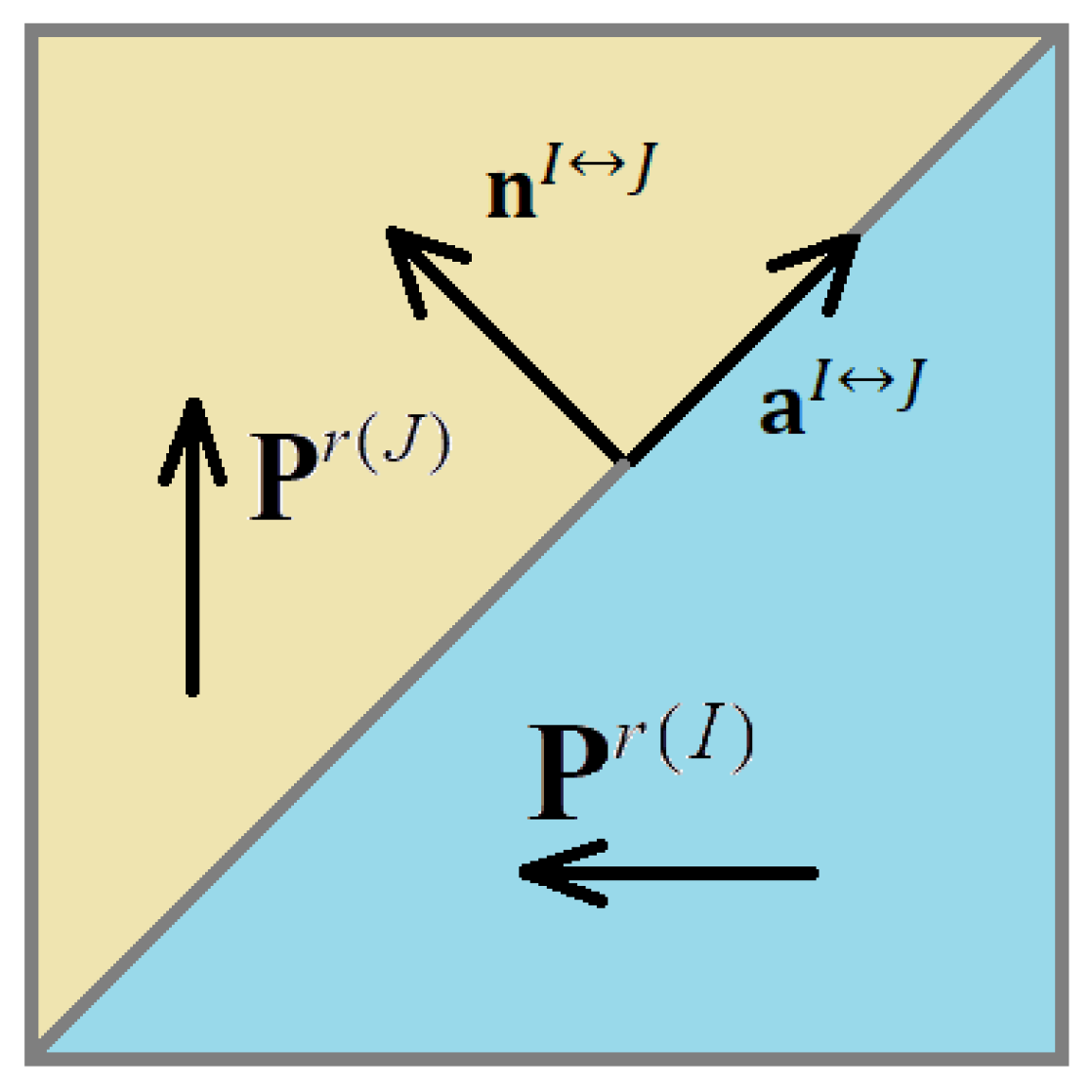
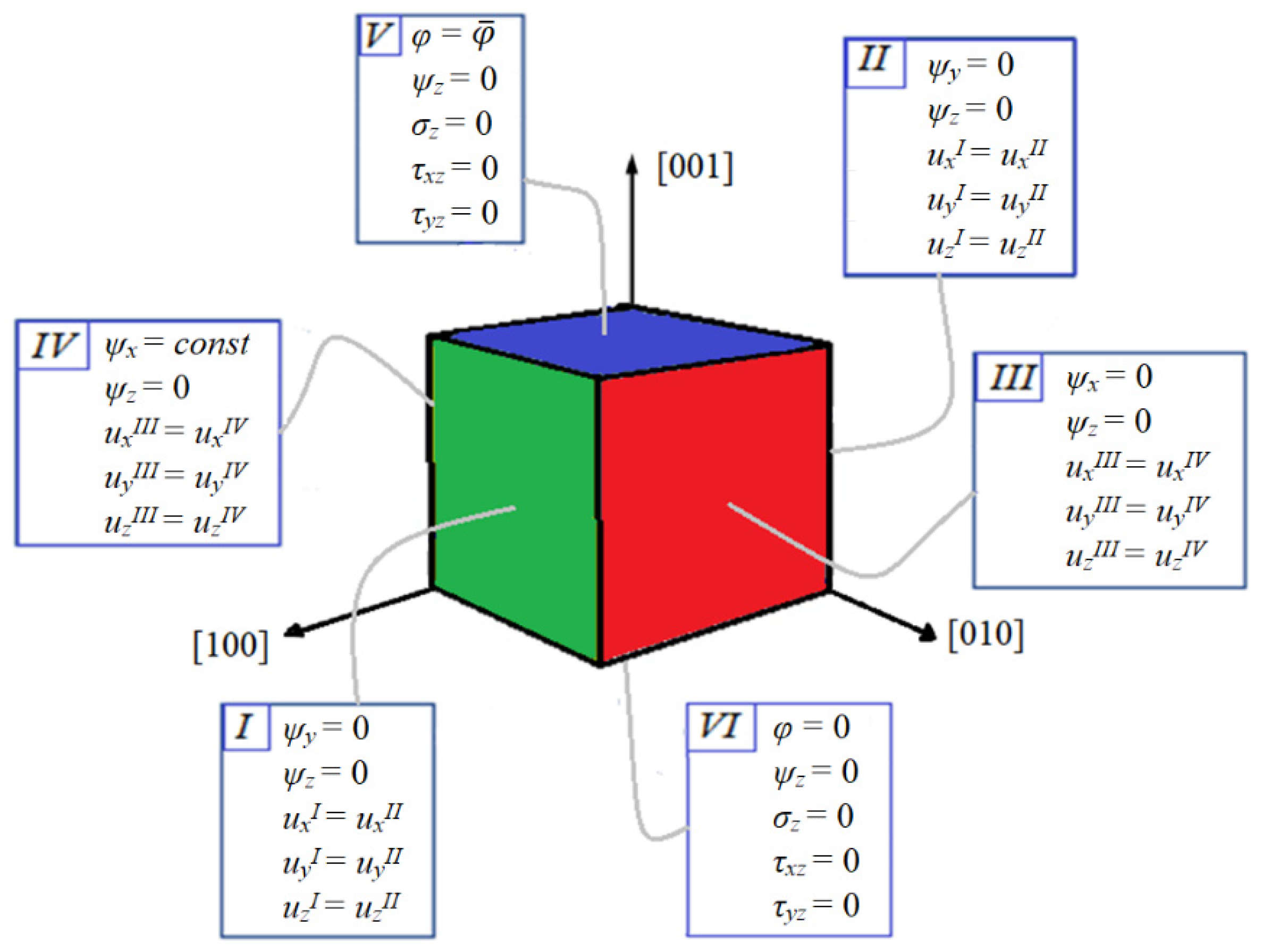
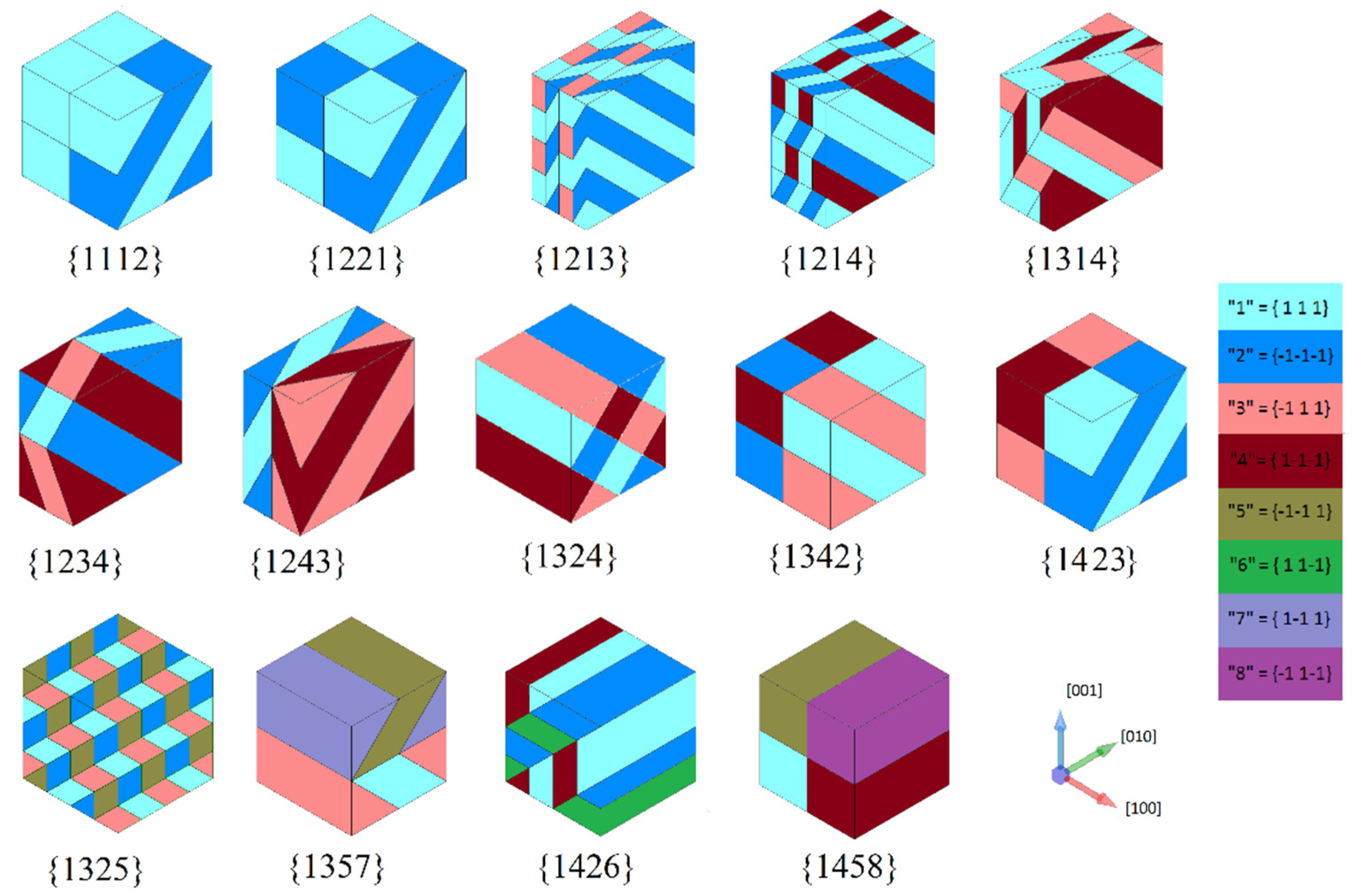
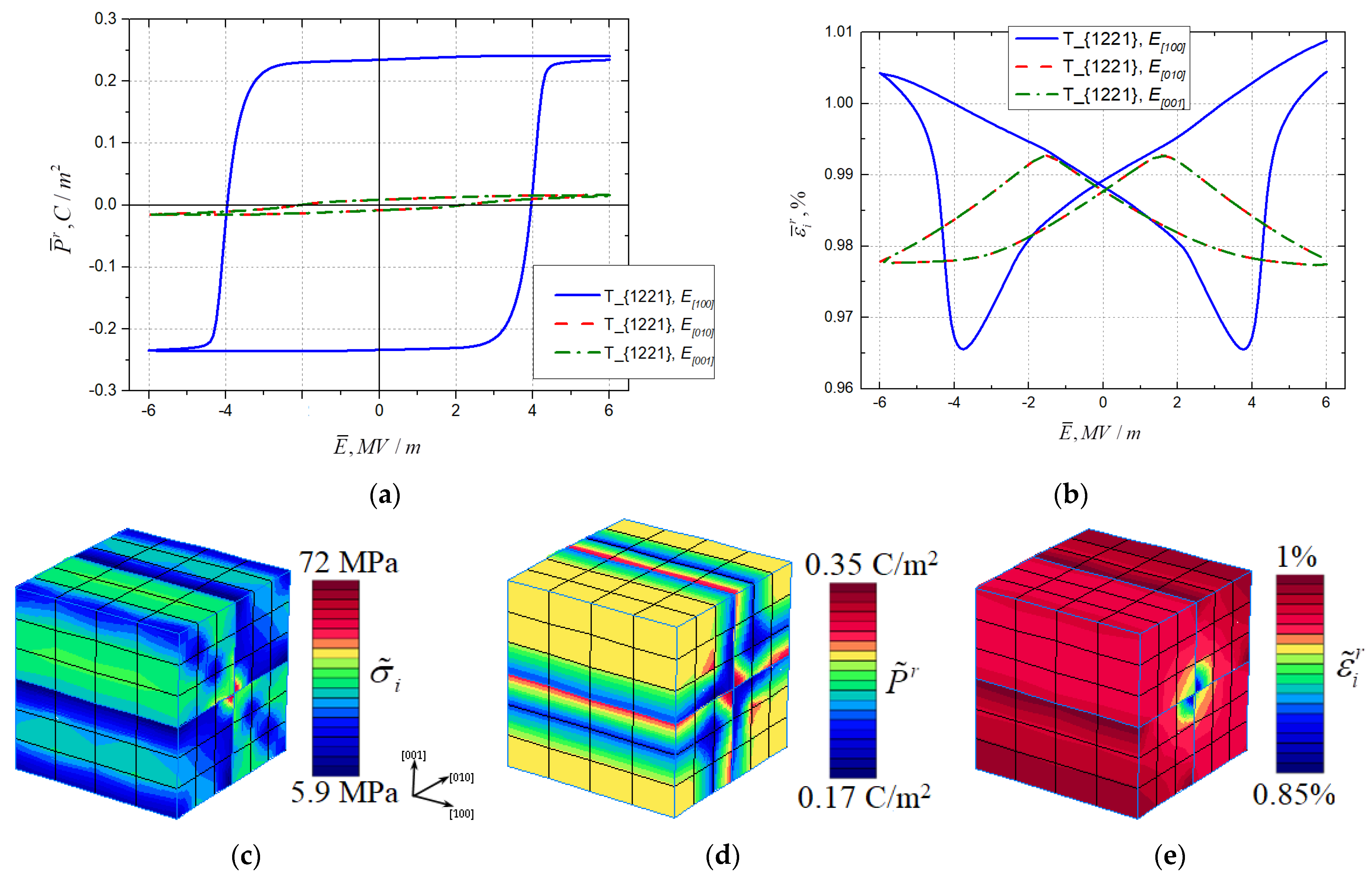
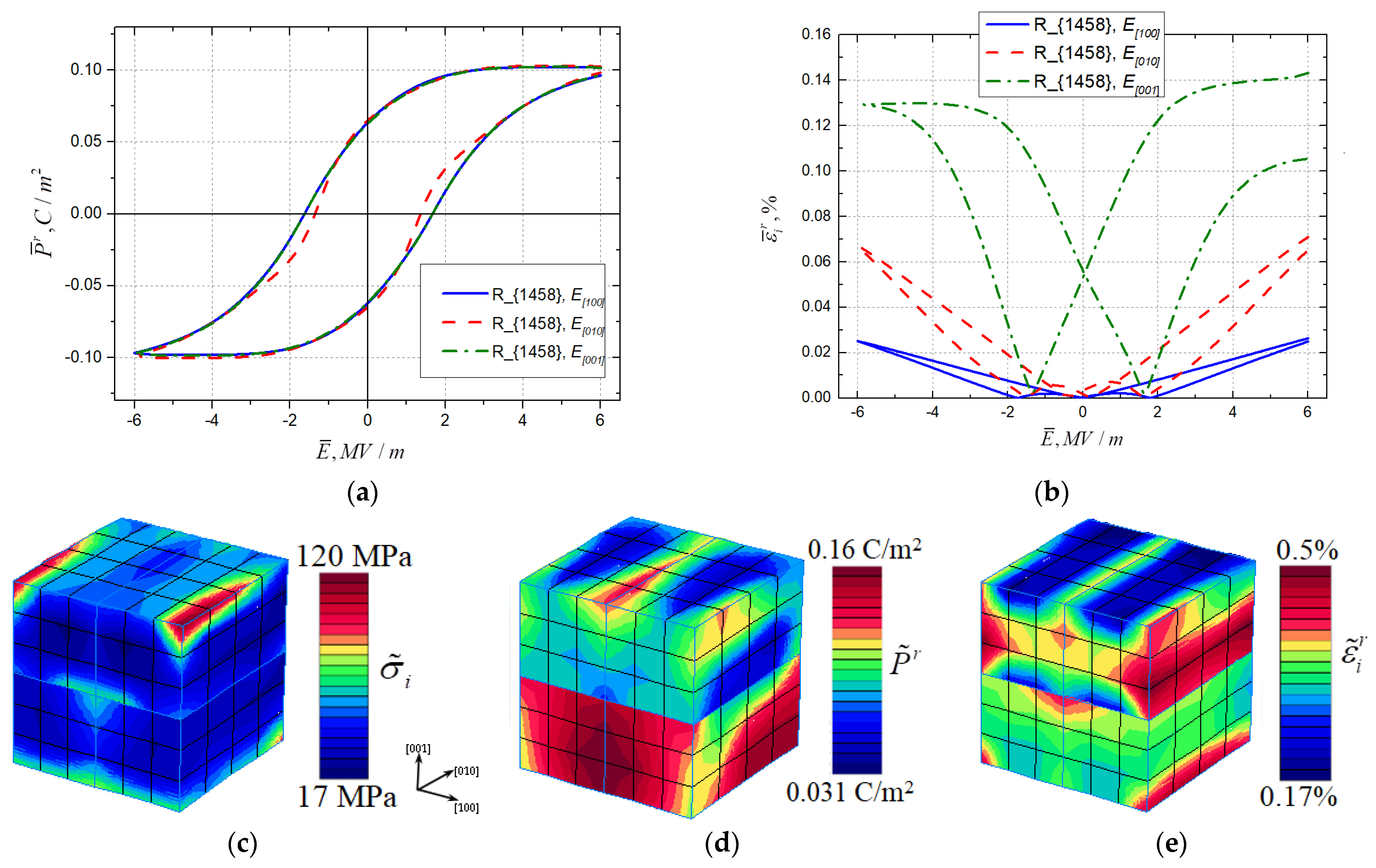
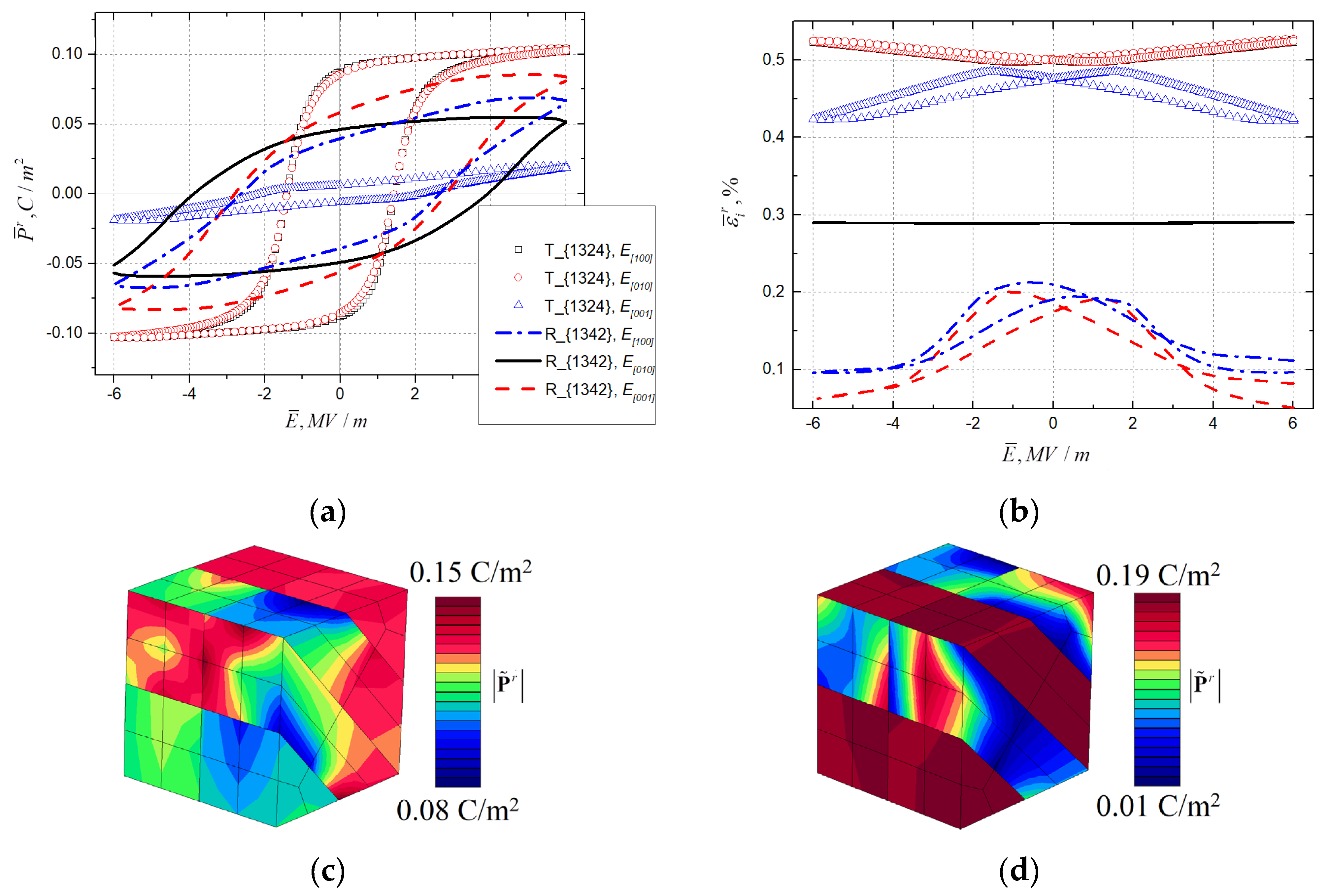
| Index | 1 | 2 | 3 | 4 | 5 | 6 | 7 | 8 |
|---|---|---|---|---|---|---|---|---|
| Tetragonal | [100] | [−100] | [010] | [0−10] | [001] | [00−1] | - | - |
| Rhombohedral | [111] | [−1−1−1] | [−111] | [1−1−1] | [−1−11] | [11−1] | [1−11] | [−11−1] |
| Model Parameters | Piezoelectric Modules, m/V·10−10 | |||||||
|---|---|---|---|---|---|---|---|---|
| Gc, [MJ/m3] | B, [1/s] | P0, [C/m2] | ε0, [−] | n, [−] | m, [−] | d131 | d311 | d333 |
| 0.63 | 1 | 0.19 | 0.01 | 6 | 3.5 | 2.41 | −1.28 | 3.15 |
| Compliance modules, 1/Pa·10−12 | Dielectric constants, F/m·10−8 | |||||||
| S1111 = S2222 | S3333 | S2211 | S3322 | S1212 | S1223 | k11 = k22 | k33 | |
| 8.18 | 11.56 | −2.58 | −2.31 | 18.40 | 8.85 | 3.24 | 5.10 | |
Disclaimer/Publisher’s Note: The statements, opinions and data contained in all publications are solely those of the individual author(s) and contributor(s) and not of MDPI and/or the editor(s). MDPI and/or the editor(s) disclaim responsibility for any injury to people or property resulting from any ideas, methods, instructions or products referred to in the content. |
© 2023 by the authors. Licensee MDPI, Basel, Switzerland. This article is an open access article distributed under the terms and conditions of the Creative Commons Attribution (CC BY) license (https://creativecommons.org/licenses/by/4.0/).
Share and Cite
Lobanov, S.M.; Semenov, A.S. Finite-Element Modeling of the Hysteresis Behavior of Tetragonal and Rhombohedral Polydomain Ferroelectroelastic Structures. Materials 2023, 16, 540. https://doi.org/10.3390/ma16020540
Lobanov SM, Semenov AS. Finite-Element Modeling of the Hysteresis Behavior of Tetragonal and Rhombohedral Polydomain Ferroelectroelastic Structures. Materials. 2023; 16(2):540. https://doi.org/10.3390/ma16020540
Chicago/Turabian StyleLobanov, Sviatoslav M., and Artem S. Semenov. 2023. "Finite-Element Modeling of the Hysteresis Behavior of Tetragonal and Rhombohedral Polydomain Ferroelectroelastic Structures" Materials 16, no. 2: 540. https://doi.org/10.3390/ma16020540
APA StyleLobanov, S. M., & Semenov, A. S. (2023). Finite-Element Modeling of the Hysteresis Behavior of Tetragonal and Rhombohedral Polydomain Ferroelectroelastic Structures. Materials, 16(2), 540. https://doi.org/10.3390/ma16020540






